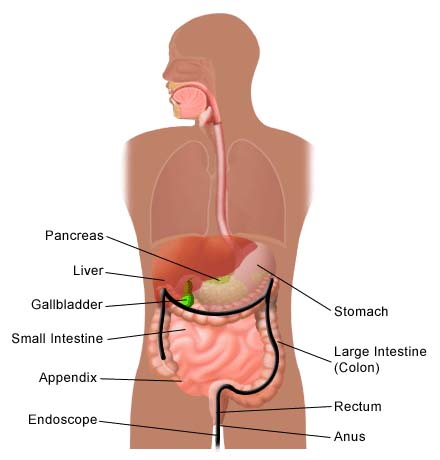What is a colonoscopy?
 Colonoscopy is a diagnostic procedure that allows your CHOC doctor to examine the entire length of your child’s large intestine. Colonoscopy can assist in identifying problems with your child’s colon, such as inflamed tissue, ulcers and bleeding. It is rare to use a colonoscopy to detect cancer in children.
Colonoscopy is a diagnostic procedure that allows your CHOC doctor to examine the entire length of your child’s large intestine. Colonoscopy can assist in identifying problems with your child’s colon, such as inflamed tissue, ulcers and bleeding. It is rare to use a colonoscopy to detect cancer in children.
An endoscope is a long, flexible, lighted tube (also called a colonoscope) that is inserted through the rectum into the colon. A colonoscope allows your child’s doctor to see inside of the colon, and to irrigate, suction, inject air and access the bowel with endoscopic instruments. During a colonoscopy, the doctor may remove tissue and/or polyps for further examination and possibly treat any problems that are discovered.
Other related procedures that may be used to assess problems of the colon include abdominal X-ray, computed tomography (CT scan) of the abdomen, abdominal ultrasound, barium enema and sigmoidoscopy. Learn more about the diagnostic tools used with gastroenterology patients at CHOC.
What are the reasons for a colonoscopy?
A colonoscopy may be used to examine colon polyps, tumors, ulceration, strictures (narrowing) and foreign objects within the colon. It may also be used to determine the cause of unexplained chronic diarrhea or gastrointestinal bleeding, or to evaluate the colon after cancer treatment. It may also be recommended based on the results of a barium enema.
There may be other reasons for your child’s doctor to recommend a colonoscopy.
What are the risks of a colonoscopy?
As with any invasive procedure, complications may occur. Complications related to colonoscopy include, but are not limited to, the following:
- Poor reaction to the sedative or pain medication
- Nausea, vomiting, bloating or rectal irritation caused by the bowel cleanse prep and/or procedure
- Persistent bleeding after biopsy or polyp removal
- In very rare cases peritonitis (inflammation of the lining of the abdominal cavity) or perforation of the intestinal wall can happen.
There may be other risks depending on your child’s specific medical condition. Be sure to discuss any concerns with your child’s doctor prior to the procedure.
Certain factors or conditions may interfere with a colonoscopy. These factors include, but are not limited to, the following:
- Use of soap suds enemas prior to the procedure, which irritate the lining of the mucosa
- Presence of barium from previous tests used to examine the colon (such as a barium enema)
- Inadequate preparation of the bowel before the procedure
- Problems that may interfere with the passage of the colonoscope, such as narrowing of the colon, surgical adhesions or disease, such as chronic inflammatory disease.












